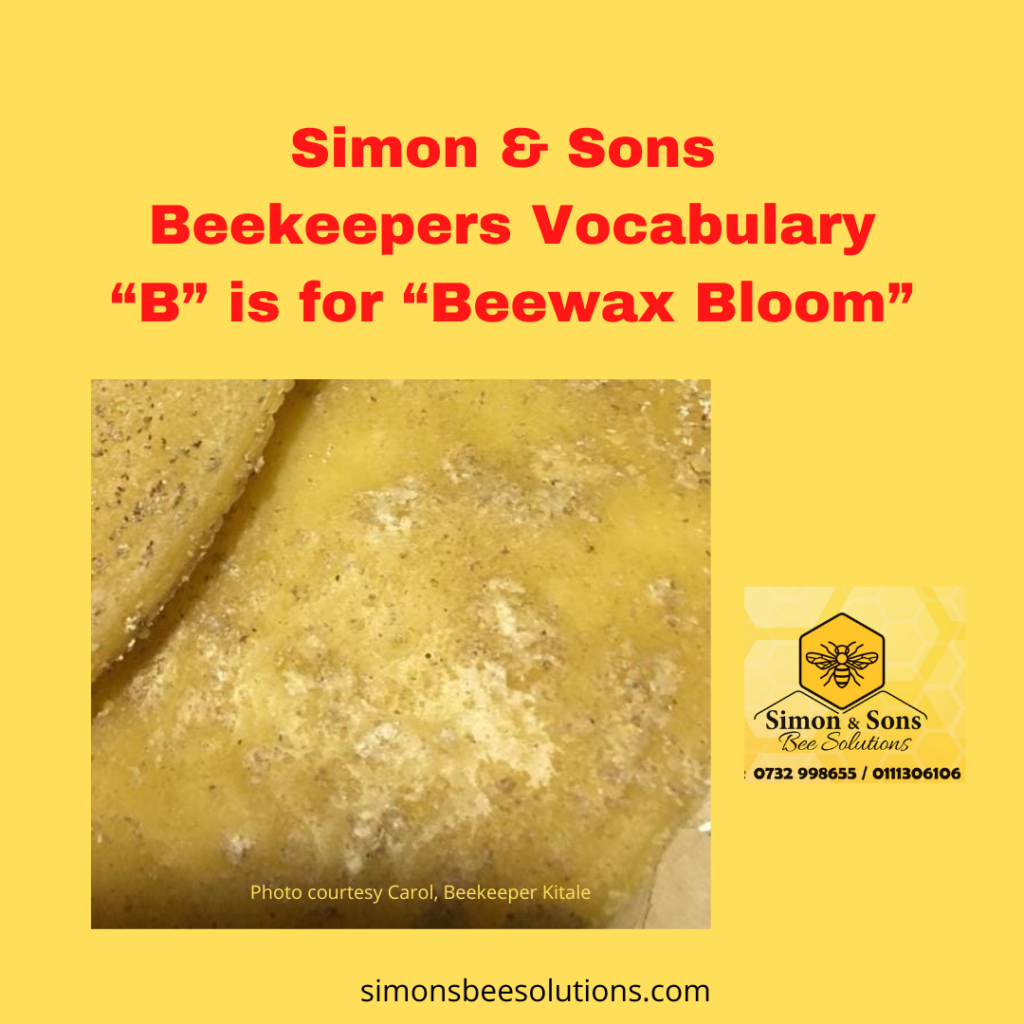 We recently received a great question, and beautiful photos, from a member of the Kilimo Bees WhatsApp group, in Kenya, Carol, a Beekeeper in Kitale, wrote to us asking…
We recently received a great question, and beautiful photos, from a member of the Kilimo Bees WhatsApp group, in Kenya, Carol, a Beekeeper in Kitale, wrote to us asking…
“I made some beeswax 👆using the cotton bag press method. After storing for some time I’ve noticed some whitish fluffy things developing in the wax. Any idea what is causing that please?”
From the photos, it appears like several things including residual particles could have been removed by straining the wax while in a liquid state ….. however… let’s elevate the response and focus on the “white fluffy things…” ama niaje??
The cloudy-looking strange white residue is a natural part of the oxidation process. This substance is known as a wax bloom or just “Bloom” in the trade.
It happens over time, especially when beeswax gets cold or there are temperature changes in storage and is simply a natural process of the softer oils of the beeswax rising to the outside surface. The bloom is a normal characteristic of beeswax, and beekeepers don’t need to do anything about it.
The powdery substance may occur on blocks of rendered beeswax and candles, or it may arise on foundation, stored combs, or honeycomb cappings. Sometimes it is snow-white,
Bloom should not be confused with mold – we see mold most often around clusters of dead bees on the comb. We rarely see mold in strong colonies, because worker bees will clean out dead bees before mold can grow…
Just as the bees make it possible for flowers to bloom, the wax they create also blooms over time. This white dusting, appears on all 100% pure beeswax, as the natural oils rise to the surface. If you find ‘beeswax’ that does not bloom suspect that it may not be 100% pure beeswax and is blended with other wax oils.
I hasten to add, that it is not always the case that you can tell 100% beeswax from paraffin wax because paraffin wax won’t bloom. Unfortunately, it’s not that simple! Some grades of paraffin also contain low-melting point components which will bloom, and others do not. Just remember that the appearance of bloom does not completely rule out paraffin, so don’t use that as the only character to determine purity.
…………Blooming Effect………..
This phenomenon is however undesirable, especially in the cases of objects with aesthetic or informational value, such as wax sculptures or historical seals.
For candle connoisseurs, however, the whitish film is an indicator of purity and is cherished. Fully developed bloom will sparkle beautifully in the light and look like crystals or snowflakes. Many candle lovers like the look of fully bloomed-candles, especially for Christmas.
If you prefer a polished look, simply buff with a soft cloth, nylon stockings, or cheesecloth. You can also run a warm blow dryer over the candle.
Wax bloom smells like beeswax, whereas mold smells and tastes like mildew. If you’ve tasted moldy bread or the moldy eye of a potato, you know the sensation.
.….Bloom should not be confused with mold…….
While mold can and does grow in beehives, especially when a colony has died, not all powdery white films are mold. It is usually just wax bloom—a normal and harmless substance that comes from the wax itself.
We see mold most often around clusters of dead bees on the comb. We rarely see mold in strong colonies, because worker bees will clean out dead bees before mold can grow.
Wax bloom is harmless
Wax bloom is completely harmless to both humans and bees. Unless you have mold allergies, most mold that grows in a beehive is also harmless, and even very moldy frames can be quickly scrubbed clean by a healthy colony.
The downside of mold on honeycombs is that it can give the honey an “off” or musty flavor. If you are unsure which one you have, smell it. Wax bloom smells like beeswax, whereas mold smells and tastes like mildew. If you’ve tasted moldy bread or the moldy eye of a potato, you know the sensation.
Natural beeswax foundation sheet for apiculture and beekeeping
.…. Rising to the surface .….
Beeswax is composed of many different chemicals, including esters of fatty acids and long-chain alcohols. In storage, some of the oils, especially those with a lower melting point, migrate to the surface and crystallize. The tiny crystals may completely cover the surface and make it appear cloudy, fuzzy, powdery, or moldy.
After the macroscopic solidification of beeswax from the melt, these molecules remain for months in a highly mobile, liquid-like state. This facilitates their diffusion to the surface, where they eventually crystallize, forming the ‘wax bloom’ effect. Although these results are of particular interest concerning the conservation of beeswax artifacts, they are relevant to this material in general and help with understanding its unique properties.
The way the beeswax was cooled affects the rate of bloom. Beeswax that is cooled quickly takes longer to bloom, perhaps a year or more. But beeswax that is allowed to cool slowly at room temperature may bloom within a few months. In theory, the longer cooling time gives the low-melting-point components time to start their migration to the surface before the wax hardens.
………First, decide what it is……
If you have frosty-looking frames of foundation or drawn comb, they can be used for bees regardless of whether they sport wax bloom or mold. Bees are good at removing mold and don’t care about color.
If the coating appears on the honeycomb that you want to extract, take the time to decide what it is. If it turns out to be bloom, you can proceed as usual. But if it is mold, you’ll want to take steps to avoid flavoring the honey.
Also, look at

